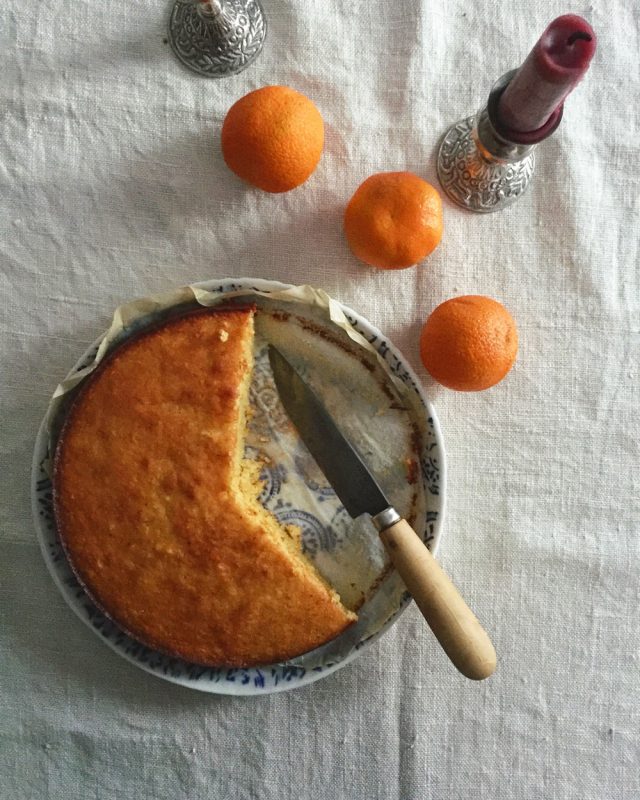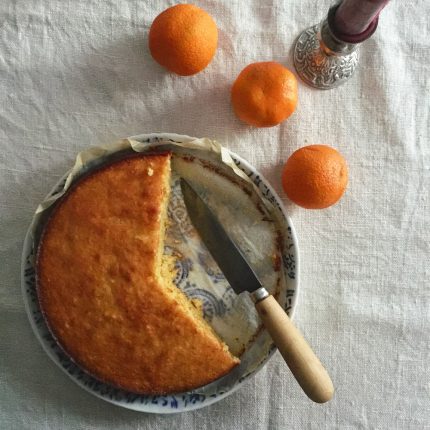Claudia Roden’s Orange Cake, kind of…

Amelia set a group of us off on citrusy cake dreams recently. It began with her posting this photo of a Sicilian orange cake (she’s also the Amelia I talk about in this heavenly sponge cake recipe). After a circuitous path, I wound my way to Claudia Roden’s orange cake, a famous recipe of which I’d never heard. How it eluded me all these years, I don’t know. The cake began with a search for recipes fitting two requirements: 1. using the whole orange, and 2. not having to cook the oranges.
I found my way to Eat, Little Bird, and this lemon cake. It was a variation on a clementine cake from Nigella Lawson’s first cookbook released back in 1998, and the inspiration for it came from Claudia Roden’s Orange & Almond Cake recipe, featured in her 1968 cookbook A Book of Middle Eastern Food.
Along the way liberties were taken with Roden’s original recipe. Nigella used clementines, as did I. Thanh used lemons. They all retained one common element—the citrus needed cooking before preparing the batter. Oranges, lemons, or clementines are simmered in boiling water for two hours, drained, then cooled before they can be grated, as in Roden’s original recipe, or blitzed in the food processor as both Nigella and Thanh did.
Friends, it was sometime around 2pm when I sat down to thoroughly read the recipe. I wanted dessert for dinner that night. There was no room for two hours plus cooling time in my life that day. So, I took a tip from Thanh, one she hadn’t tried, but heard of—I used the microwave to cook the clementines. You’re either aghast at this notion, or think it’s genius.
Let’s step back one moment because if you’re a new baker, or just not experienced working with citrus in this manner, you might be asking the obvious.
Why does the citrus need to be cooked at all? Citrus has three layers—zest, pith, and finally the fruit hidden within. The pith is that white part between the fragrant zest, and juicy flesh. It’s quite bitter, and while it pairs nicely with an espresso, as my family did growing up, a more mellow approach is often preferred for baking. Cooking it draws out the bitterness. This is a common method when making candied citrus peel and marmalade.
Amelia used the whole orange raw in her cake, and I’m quite curious to try that approach, too. I love the contrast of something faintly sweet and bitter to balance out a savory meal. I’m going to give it a try, and with her blessing, might share the recipe in the future.
Back to the cake at hand, though.
Two minutes in my 700 watt microwave did the job perfectly. They emerged from the microwave slightly swollen and soft. Yes, I was worried they might explode, so keep an eye on your fruit. I let them cool about 15 minutes before proceeding with the recipe. Please note that you might need more or less time depending on the size your microwave. Or you can boil them if you don’t like microwaves. Most people are surprised I even own one, but really it mostly gets used for melting butter, occasionally popcorn, and rarely ever chocolate, since I prefer doing that on the stovetop with a double boiler. That covers all you need to know about my microwave ownership and habits.
I decided to halve the recipe since smaller cakes work perfectly for my family of three. I also wasn’t convinced the girls would like this cake. Almost every recipe gently warns it’s a wet consistency, even after fully baking. Nigella calls it a “wonderfully damp, dense, and aromatic flourless cake”. Oh, yes. I forgot to mention that. This Clementine Almond Cake (let’s call it what it is finally!) is both gluten-free and dairy-free, giving it extra appeal for me since I’m trying be a bit more healthful after the holiday indulgences, and recent trip to Paris.
I didn’t mind the cake on day one. Yes, it was moist. I know, the food writing police tell us we’re not supposed to use that word. Whatever. Considering my knowledge on baking and how cakes age, I had a hunch it would be downright delightful in 2 to 3 days. I was right. I left it on the dining table, uncovered, even went away overnight, and when I came back to nibble on this cake it was perfect in every way. The rest at room temperature, uncovered, allowed the crumb to dry out a bit, but not too much. It also gave the clementine time to really infuse into the flavor of the cake.
This is where I ask you to forgive me in advance—
The recipe is in metric measurements. I know some of you really dislike them. One reader went so far as to email me that she wants her recipes in cups. I found this odd, almost rude, mainly because her email had no salutation, no warmth, just a reply to my automated email with new posts that read, “i like my recipes in cups”. Um, okay.
Here’s the thing. Part of my focus here, for now at least, is pulling back to the reason I began my blog 10 years ago. I wanted a place where I could write about what I was cooking in my real life, not editorial life where recipes are often prepped months in advance (hello, roasting turkeys in July). Ironically, back then I did work in volume exclusively since I’d yet to discover the absolute joy and freedom working by weight allows.
I do hope you’ll give the recipe a try because it’s a lovely one. Perfect with afternoon tea, also a nice, not-too-sweet way to end the evening, and I venture to say a slice would be a great grab & go breakfast.

Claudia Roden's Orange Cake, kind of...
Ingredients
- 200 grams clementines about 3 whole ones
- 125 grams sugar
- 125 grams blanched almond meal
- 3 eggs
- 1/2 teaspoon baking powder
Instructions
- Preheat the oven to 375°F (190°C).
- Cook the clementines in the microwave for 2 minutes, until slightly swollen and softened. Let them cool enough to handle, and keep in mind the actual cooking time varies on the wattage of your microwave (mine is 700 watts).
- Add the cooled clementines to a food processor, and pulse until pulverized with some small bits intact (imagine a blender could work, too).
- Transfer chunky clementine puree to a bowl. Add the eggs, almond flour, sugar, and baking powder. Stir until just mixed.
- Scrape into a greased 8-inch springform tin. Bake at 35 to 40 minutes, until set and a skewer inserted in the center comes out clean. Let cool completely before serving. See original post for further serving note.

Angie G
Love you! and I love your blog and have followed you for so long. love your recipes too. I’m not a frequent commenter, so my apologies for the random interjection here, but I had to comment on this post because I am obsessed with this recipe! I tried it the very first time I watched Nigella make it in the dark in her kitchen on her TV program. I RAN to the kitchen to make this! I committed to the whole thing, boiling the clementines and everything, BUT, am I the only person who does not like almond meal/flour? I just.. can’t. Maybe it’s a textural thing? I was deflated… and now your making it too? what am I missing? Can I make this w/another type of flour? I want to love this cake, it sounds like everything I want and need… except for the texture of the almond meal/flour. Interested in using alternative flour for this if possible…. And I hope that the reader that wants her recipes in “cups” finds peace. Really? lol!
LindaSonia
Is there a metric conversion of the ingredients somewhere??
LindaSonia
Apparently, I missed reading some comments above – disregard my previous question.
Jennie
Hi, Angie. I understand your comment about the texture of almond meal. It is certainly an acquired taste. And in this cake, it very texture forward (is that even a term?). That said, once the cake has had few days to settle, the almond flour absorbs the excess liquid, making it less grainy. I’m not encouraging you to make this again if you already know what you like vs. don’t like, but wanted to throw that out there in case is affects you decision to give it a go again. Not having tested it with regular flour, I can’t say how it would work, or what the correct measurement for all purpose flour would be. If you decide to give it a try, though, please feel free to come back here and leave us all a note. And don’t worry about any FOMO—everyone has their own tastes, and maybe this cake just isn’t for you. You should try the lemon honey cake I have on the blog (type (https://www.injennieskitchen.com/2017/06/lemon-honey-olive-oil-cake/). That is flour-based, and you can try substituting oranges or clementines for the lemons. Hope that all helps! xo-Jennie
Judi
I have been enjoying your blog and recipes for a while. This cake sounds delish. Can mandrian oranges be substituted for the clementines??? I always have bags of the Cutie or Halo brand of mandrian oranges from Calfornia around during the winter months. Could they be used instead??
Jennie
Judi—as long as they’re seedless, that should be fine.
Carmen
Jennie,
I noticed the cake sitting on parchment paper in the accompanying photo. Is that just for serving/presentation? I know the recipe calls for greasing the 8-inch springform pan but did you also line it with parchment? Was just wondering…
Jennie
Hi Carmen. Yes, I always line my pans with parchment. Just makes for easier handling, especially with a cake like this. -Jennie
Elaine
Any reason you can think of that I couldn’t use pistachio meal? Almond isn’t my favorite flavor, while pistachio, on the other hand…
Jennie
I’ve not made it with pistachio meal, so can’t speak to the results, but do let us know if you give it a try.